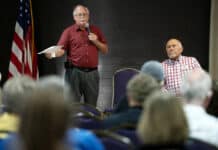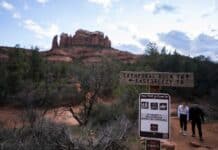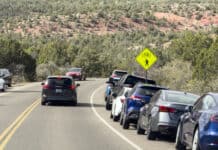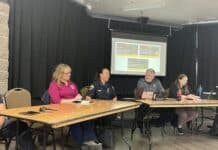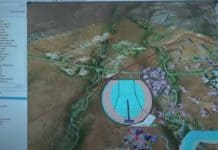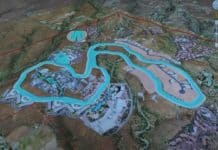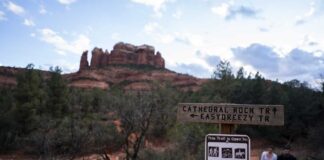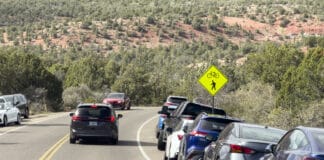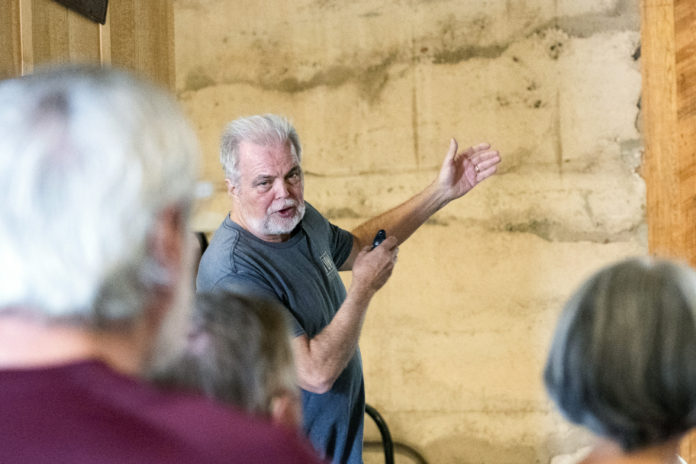
Meandering throughout Arizona, one finds American Indian villages, old Mormon settlements, cow towns, mining camps, swimming holes, ghost towns, wildlife parks, state parks, trading posts, wineries and swinging door saloons — there is even a town run by burros.
In fact, it’s the only state in the nation where you can hike into one of the Seven Natural Wonders of the World, sleep in a teepee, drive down Route 66 or stand on the corner of Winslow, Arizona.
According to author and explorer, Roger Naylor, “to put it mildly, when you go outside to play in Arizona, you’re in the big leagues. Hard to imagine a place more perfectly designed for road trips.”
Naylor should know all about Arizona — especially the road trips. He’s a road trip junkie. He says that he has rambled around poking into every nook and cranny and has driven the state’s 27 scenic and historic roads — including five National Scenic Byways.
He has been writing about the Grand Canyon State for more than four decades and authored eight books: “Arizona State Parks: A Guide to Amazing Places in the Grand Canyon State,” “The Amazing Kolb Brothers of Grand Canyon,” “Boots & Burgers: An Arizona Handbook for Hungry Hikers,” “Arizona Kicks on Route 66,” “Death Valley: Hottest Place on Earth,” “Crazy for the Heat: Arizona Tales of Ghosts, Gumshoes and Bigfoot,” — and his latest book, “Arizona’s Scenic Roads and Hikes: Unforgettable Journeys in the Grand Canyon State — proving that he is a road warrior of the entire state with terrain that varies from the hot dry desert in the south to an alpine tundra at the highest point of the San Francisco Peaks.
Sitting at a picnic table in Dead Horse Ranch State Park in Cottonwood, a place not far from his home — Naylor was in his element. He routinely takes hikes around the park enjoying the scenery and loves listening to birds in their natural habitat. He mentioned the numerous trails and waterways, pointing to the area where he once camped and toured a section close to the Verde River where owls roost. This is his sanctuary.
Naylor wrote of Dead Horse Ranch State Park: “We all need places where we can be outdoors and connect with nature, where we can see flowers and greenery and mountains and blue sky and hear bird song and lizard feet and leaves rustling in the breeze and smell the soil and grasses and dust — the heady aroma of the earth. We need open spaces. We need parks and forests and preserves and every quiet corner of nature we can find. They are an essential quality of life issues where we can recharge and regenerate. They allow us to breathe again and remember what’s truly important in this world. They can be as small as your own backyard or as vast as Grand Canyon. We all need safe harbors. I am blessed to have lots of them in Arizona, but my main one just happens to be a park named for a deceased equine.”
Naylor grew up in Cincinnati, Ohio, a city quite different from the rugged terrain of the West. However, he said that he grew up watching Western movies and “loved the cowboy action and the stories but was really fascinated by the scenery.”
“Growing up in Ohio, you didn’t see mountains, you didn’t see monoliths, you didn’t see the Grand Canyon, you didn’t see all these things. And so, I was just really drawn to the west. I knew this is where I was going to go.”
Naylor attended Northern Arizona University in Flagstaff in 1975 and immediately fell in love with Arizona. He said, “that was it. I knew right from the start that I was going to live here.”
Naylor says that he fell “too much in love with Arizona.” He was on the dean’s list the first semester of college and by the second semester, he was on academic probation because by then he realized that he could get up in the morning and walk to class or he could hitchhike to the Grand Canyon or Sedona or go to the desert instead.
Naylor dropped out of college and spent the next four years rambling around the state and around the West. He would work when he ran out of money and hitchhike when he didn’t have a car or drive to an unexplored destination when he did have a car.
He says that it was a great adventure — except his parents didn’t think so.
“They thought that I was turning into a drifter, but I was just actually a travel writer in training. I didn’t know it yet,” he said.
At age 13, Naylor knew that he wanted to be a writer.
“I picked up a book of Mark Twain essays, they weren’t even stories, they were just essays,” he said. “I was overwhelmed. He made me feel things. He made me think about things. He made me happy; made me sad. He made me experience emotions. I didn’t know you could do that. And it was just all the power of those words.
“I thought, that’s what I’m going to do. I’m going to be a writer.”
By the time he was 18, Naylor knew the two great truths of his life — he knew he was going to be a writer and he knew he was going to live in Arizona.
“I didn’t know how they were going to come about,” he said. “But you know, I just kind of kept working at that. I’ve always written. I’ve always scribbled in notebooks and I’m completely self-taught. So, I just kind of had to teach myself every step of the way.”
Naylor’s path may have been predestined in a succession of events leading him in the right direction. He worked a multitude of jobs before becoming a bartender. The bar owner wanted a comedy show and asked Naylor to run it.
“I started running these comedy shows,” he said. “That evolved into me doing comedy and doing stand-up for a while … giving me a launching pad. I became known in Cincinnati and I started writing for local papers, radio, magazines — so that’s kind of how it evolved.”
Naylor loves to write because “It’s just me and my notebook and my pencil, scribbling and then typing some stuff up.”
Expressing his thoughts on paper is so pure, he said, it’s exhilarating, it’s just thrilling, as he immerses himself in his craft, void of life’s distractions.
“I think it does get tougher [to write] as you get older,” he said. “I’m a better craftsman at my writing. But I still want to make sure that I have that passion. I still want to make sure that I’m saying things in a different way and I still want to make sure that I’m bringing my particular voice to the topic.”
“So sometimes it feels like it’s a little harder … where before I was cranking it out,” he said. “Now, I need a little more time. The brain is not as elastic as it used to be now that I’m an old geezer.”
Naylor writes every day, seven days a week and there is never an off day.
“Some days it’s just a few scribbled notes — the old-fashioned way — pencil in hand, writing everything out on a legal pad,” he said. “I like the tactile sense of it [pencil on paper]. I like the feel of it.”
“I think I was born in the wrong era,” he said. “I used to love those old typewriters. I like the feel of a pencil, a good sharp pencil biting into the paper. And I like you know, seeing the little scribbled words — the little notes in the margin, my handwriting is so awful anyway, I can barely read and it’s just a horrible scroll across the page. But it still it connects me to the words more so than tap, tap, tap, tap, tap on the laptop.”
As Naylor gets into the rhythm of writing, he claims that he is tone-deaf, can’t sing nor clap to a song, however when he’s writing sentences and when it’s flowing, he hears that rhythm in his head.
“When I’m writing, I can feel the words pulling me forward,” he said. “I can feel that I’m hitting the right beats I can tell which sentence needs another word. I can tell which sentences are too short … it’s just all rhythm.
As for the subject matter, what he writes about is easy.
“I never run out of ideas,” he said. “I never run out of stuff to write about, because we have such a remarkable state. There’s such incredible diversity, there’s so much to see and do and experience. The history is so rich. So, coming up with ideas is not hard at all …. I write about what I love. And if I’m passionate about it, I think that comes across on the page.”
As he uncovers new things, what to leave out is challenging.
“With everything I write, the hardest part about any story is what to leave out,” he said. “Because you always find so much more great stuff.”
Naylor says that he never expected that the desert would capture his heart like it did, but as he explores the state that he loves, he is constantly discovering new things. His favorite little getaway is in Cochise County, in the southwest corner of Arizona. There one will find the Chiricahua National Monument, tombstones, Wild West history and Bisbee.
“I’ve been incredibly fortunate that I’ve lived a blessed life,” Naylor said as he reflects on his life. “I actually got to live the life that I wanted to live and not many people get to do that. I got to choose my own path and I worked very hard at it. Nothing was handed to me. I had to succeed at every step of the way. I had to teach myself how to do something every step of the way. It was all a learning process.”
“At the end of my days, if I know that it’s my last moments, I’m not going to say that I wish I could have had more time,” Nayor said. “I would do exactly the same thing as I’ve been doing. I have no regrets. I’m not going to croak and say, ‘I wish I’d gone to China. I wish I had swam with the dolphins. I wish …’ I’m going to be on my deathbed saying ‘I wish I could get to the Grand Canyon one more time. I wish I could get down to the Chiricahua one more time and I wish I could sit in the sun at Paria Canyon one more time.’ I just want more of the same because I’ve done exactly what I wanted to do


